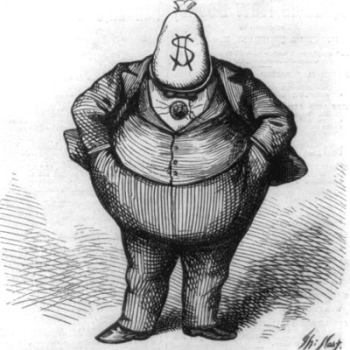Newspaper's lead story is a mean old lie.
Here's the lead graf from today's front-page USA Today story by Barbara Hagenbaugh:
Taxpayers' refund checks will increase nearly 27 percent to an average $2,500 per family early next year, according to new forecasts from tax experts and economists, who say the windfalls will aid consumers, the economy and President Bush's re-election campaign.
Wow. That's quite a figure. An average 27 percent increase in the tax refund for American families. Bravo!
Oh, but wait. What exactly does Hagenbaugh mean by "average"?
Surely she's referring to the median, right? I mean, otherwise — if that "average" is just a mean — the story is completely meaningless, not to mention sleazily deceptive, since it implies that the "average" family will be receiving an "average" refund of $2,500 when, in fact, the typical family might receive far less.
So I called the nice folks at Gannett News Service to confirm that Hagenbaugh was referring to the median tax refund and not either displaying a shameful innumeracy or a contemptible dishonesty.
"It's a mathematical average," I was told, which didn't really clarify anything.
ME: What kind of average?
GNS: "It's just a plain old average."
ME: A mean?
GNS: "I guess so, it's just an average."
In other words, Hagenbaugh's story isn't a story at all. It's a meaningless waste of column inches on the front pages of one of the country's largest newspapers.
Meaningless, but not harmless. While the story may not convey any actual information to the reader, the reader is likely to walk away thinking they've learned something. They may walk away thinking they're going to get a $2,500 tax refund.
It's not even clear how Hagenbaugh is calculating the mean she presents. She tells us, using figures apparently supplied by tax-software maker Petz Enterprises, that 108 million households will be splitting $227 billion. Divide $27 billion by 108 million and you get $2,102 (the difference may be one figure is for "households," the other for "families" — although the meaning of this distinction is not clear from the article).
The deceptive misuse of averages has become a standard tactic of the Bush administration in hyping the supposed benefits of its tax cuts. We saw this earlier this year, when the president on Jan. 7 claimed that because of his tax cut: "Ninety-two million Americans will keep an average of $1,083 more of their own money."
I wrote about this here, noting that while the average taxpayer would save far less than that, the president would personally save much, much more — about $44,500.
If any of Hagenbaugh's shoddy arithmetic is to be believed, and Bush receives the 27 percent increase she's hyping, then he stands to get back more than $56,000 this year because of legislation he passed. (Far be it from me to suggest that George W. Bush would sell his integrity for a mere $56,000. His asking price is usually at least six figures.) A 27 percent increase would mean Dick Cheney stands to get back about $415,000 — which is a lot of money even for Dick Cheney.
Writing in The New Yorker about Bush's earlier use of misleading averages, Hendrik Hertzberg characterized Bush's statement as true, but:
… only in the sense that it is also true that if Bill Gates happened to drop by a homeless shelter where a couple of nuns were serving soup to sixty down-and-outers dressed in rags, the average person in the room would have a net worth of a billion dollars. Average, yes; typical, no. A typical taxpayer — one right smack in the middle of the income range — will get a couple of hundred dollars. And a worker in the bottom 20 percent will get next to nothing — at most, a dime or a quarter a week.
Bush, Hagenbaugh and USA Today are literally taking a chapter out of the book on How to Lie With Statistics. Chapter 2, in fact, of Darrell Huff's invaluable book. The chapter is called "The Well-Chosen Average."
The "well-chosen average" can be particularly misleading when dealing with something like household incomes, which, if plotted on a graph, would provide a steeply accelerating curve. That curve has a definite lower limit, but no meaningful upper limit. There are 184,000 millionaires in this country — more than enough to blow the curve for typical families closer to the median household income of $42,409.
I encourage you to read the whole chapter, online here.
I'd also suggest this as mandatory reading for Barbara Hagenbaugh, the editors of USA Today and anyone else involved with the Gannett News Service.
In the meantime, we can look forward to Hagenbaugh's upcoming series of exclusive interviews with top Bush administration officials. I'm assuming she gets something in exchange for parroting their sleazy, disingenuous propaganda.












